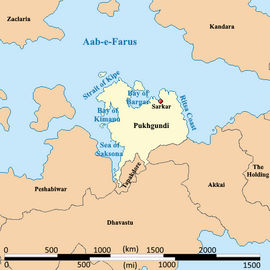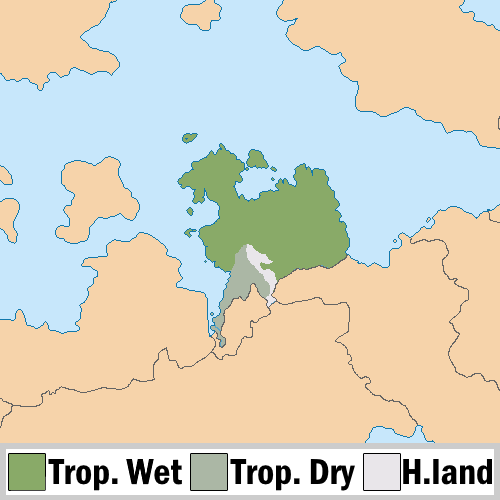Pukhgundi: Difference between revisions
m (→Prehistory) Tags: Mobile edit Mobile web edit Advanced mobile edit |
mNo edit summary Tags: Mobile edit Mobile web edit Advanced mobile edit |
||
| Line 136: | Line 136: | ||
Despite its advancements, the Umaronid Empire eventually declined. While the precise reasons remain unclear, factors such as climate change, shifting river courses, and migrations likely played a role. Nevertheless, the legacy of the Umaronids endures, providing valuable insights into the social, economic, and cultural dynamics of early [[Audonia]]n civilizations. The empire's contributions to urban planning, metallurgy, and artistic expression continue to inspire and inform contemporary understanding of the region's history. | Despite its advancements, the Umaronid Empire eventually declined. While the precise reasons remain unclear, factors such as climate change, shifting river courses, and migrations likely played a role. Nevertheless, the legacy of the Umaronids endures, providing valuable insights into the social, economic, and cultural dynamics of early [[Audonia]]n civilizations. The empire's contributions to urban planning, metallurgy, and artistic expression continue to inspire and inform contemporary understanding of the region's history. | ||
=== | === Classical Antiquity === | ||
{{Further|Arunid Empire}} | {{Further|Timeline_of_major_world_events#Classical_Antiquity|Arunid Empire}} | ||
<gallery mode="packed"> | |||
</gallery> | |||
Modern Pukhgundi formed the administrative and cultural core of the [[Arunid Empire]] during classical antiquity. The Kingdom of Pondichundie that formed the base of the empire included most of Pukhgundi and eastern [[Tapakdore]]. | |||
===Oduniyyad Caliphate=== | ===Oduniyyad Caliphate=== | ||
Revision as of 12:58, 30 June 2024
This article is a work-in-progress because it is incomplete and pending further input from an author. Note: The contents of this article are not considered canonical and may be inaccurate. Please comment on this article's talk page to share your input, comments and questions. |
Republic of Pukhgundi | |
|---|---|
|
Flag | |
 Location of Pukhgundi | |
| Capital | Sarkar |
| Largest largest city | Tarigar |
| Official languages | Pukhti, Burgoignesc |
| Ethnic groups | Primarily Pukhti Gorkhas |
| Religion | Primarily Hindu |
| Demonym(s) | Pukhgundti |
| Government | Republic |
• President | Nandakishor Mitra |
| Establishment | |
• Independence | 1811 |
| Area | |
• Total | 387,669.42 km2 (149,680.00 sq mi) |
| Population | |
• Estimate | 42,600,400 |
• Density | 109.888/km2 (284.6/sq mi) |
| GDP (nominal) | estimate |
• Total | $907,558,921,600 |
• Per capita | $21,304 |
| Currency | Common Middle Sea Florin (CMS ƒ) |
| Driving side | right side |
Pukhgundi, officially the Republic of Pukhgundi, is a minor-power sovereign country central in western Audonia. It is bound by the Aab-e-Farus in the north, Tapakdore in the southwest, Dhavastu in the south, Akkai in the southeast, and the Sea of Saksona in the west. It is a constitutional republic with universal suffrage is praised for holding consistently open and fair elections in the Region.
It is a member of the League of Nations, the International Red Cross and Red Crescent Movement, and many other international organizations. It is a emerging market, market economy focused on exports, under the watchful eye of Burgundie whose companies have a massive stake in the country's economic activity. It is an active member in the Middle seas region's economic activity. Many scholars have criticized its economic governance and politics, arguing that it is merely a client of the Burgoignesc thalattocracy's economic and cultural might.
The people of Pukhgundi are predominantly culturally Pukhti Gorkha, speak Pukhti , and most practice Hinduism.
Geography
Climate

History
Prehistory
Umaronid Empire
The Umaronid Empire, a Bronze Age civilization that thrived in western Audonia from approximately 3300 to 1300 BCE, left an indelible mark on the region. Renowned for their meticulous urban planning, the Umaronids constructed sprawling cities like Harappa and Mohenjo-daro, characterized by grid-like layouts, multi-story houses, and sophisticated drainage and water supply systems. This meticulous attention to detail extended to their economic practices, evident in their standardized weights and measures that facilitated trade and commerce across the empire. The Umaronids demonstrated exceptional craftsmanship and technological ingenuity. Their mastery of metallurgy is evident in the production of bronze tools and weapons, while their artistry is showcased in intricate seals, pottery, and figurines. Notably, the empire developed a unique script, yet to be deciphered, which tantalizingly hints at a complex language and potentially rich literary traditions. Despite its advancements, the Umaronid Empire eventually declined. While the precise reasons remain unclear, factors such as climate change, shifting river courses, and migrations likely played a role. Nevertheless, the legacy of the Umaronids endures, providing valuable insights into the social, economic, and cultural dynamics of early Audonian civilizations. The empire's contributions to urban planning, metallurgy, and artistic expression continue to inspire and inform contemporary understanding of the region's history.
Classical Antiquity
Modern Pukhgundi formed the administrative and cultural core of the Arunid Empire during classical antiquity. The Kingdom of Pondichundie that formed the base of the empire included most of Pukhgundi and eastern Tapakdore.
Oduniyyad Caliphate
Pukhgundi colony
Tea, silk, teak plantations, textiles
Modern-day period
First Great War
Politics and government
Society
Economy and infrastructure
The economy of Pukhgundi is characterized as an emerging market economy, heavily reliant on exports and foreign investment. It is classified as a lower-middle-income country, with a GDP per capita of $21,304. The economy is largely agrarian, with basmati rice, rapeseed, mustard seed, jute, potato, sweet potato, banana, papaya, areca nut, sugarcane, turmeric, Assam tea, and Assam silk being major agricultural products. Teak is the primary timber export. The fishing industry contributes to the economy, with anchovies, scad, shrimp, and Indian mackerel being the main catches. Mining, particularly of tin, bauxite, and copper, also plays a role.
Standard of Living and Employment
Pukhgundi's standard of living is relatively low compared to global averages. Poverty remains a significant challenge, with a large portion of the population engaged in subsistence agriculture or informal employment. While there has been some improvement in recent years, income inequality remains high. The unemployment rate is officially reported at around 6%, but underemployment is widespread, especially in rural areas.
Key Sectors
* Agriculture: This sector employs the majority of the workforce and contributes to around 25% of GDP. The primary crops are rice, jute, potatoes, tea, and silk. The government has invested in irrigation projects and agricultural research to improve productivity. * Manufacturing: While still limited, the manufacturing sector is growing, focusing on import substitution of consumer goods and basic materials. There is also some production of textiles and garments for export. * Telecommunications: This sector is experiencing rapid growth, driven by increasing mobile phone penetration and competition between state-owned and private providers. Internet access is also expanding, though it remains limited in rural areas. * Mining: The mining industry is relatively small but contributes significantly to export earnings. Tin, bauxite, and copper are the main minerals extracted. * Tourism: Pukhgundi has significant potential for tourism due to its natural beauty and cultural heritage. However, the tourism sector is still underdeveloped, with limited infrastructure and marketing efforts.
Foreign Investment and Involvement
Foreign investment, primarily from Burgundie, plays a crucial role in Pukhgundi's economy. Burgoignesc firms have significant stakes in various sectors, including agriculture, mining, manufacturing, and telecommunications. This foreign investment has brought in capital and technology, but has also raised concerns about economic dependency and potential exploitation.
Trade and Exports
Pukhgundi's main exports include agricultural products (rice, jute, tea, silk), minerals (tin, bauxite, copper), and seafood (anchovies, scad, shrimp). The country's primary trading partners are Burgundie, Middle seas region nations, and some Levantine countries. The government has implemented policies to promote exports and diversify trade partners.
Infrastructure
The infrastructure of Pukhgundi is a mix of modern and developing systems, reflecting the country's emerging market status and its reliance on foreign investment. Significant improvements have been made in recent decades, particularly in the areas of transportation and telecommunications, due in part to investments from Burgundie during Operation Kipling in the 1960s-early 1980s.
Energy
Pukhgundi's energy sector is predominantly reliant on fossil fuels, particularly coal and natural gas, for power generation. However, there has been a growing trend towards renewable energy sources like hydropower, solar, and wind power, as well as biofuels, since the 1990s. The government has set targets to increase the share of renewables in the energy mix, but challenges remain in terms of financing and infrastructure development.
Transportation
- Railways: Pukhgundi uses Standard gauge, 1,435 mm (4 ft 8+1⁄2 in) as most of its rail infrastructure has been under the auspices of Burgundie and its sphere of influence in the Middle seas region, who all use that rail gauge. Its network connects major cities and industrial centers. The system is primarily used for freight transportation, especially for agricultural products and minerals. Passenger services are limited and primarily focused on intercity routes. The railway infrastructure is maintained by the state-owned Pukhgundi Railways.
- Highways: The country has a relatively extensive road network, connecting major urban areas and economic centers. However, the quality of roads varies significantly. While major highways are paved and well-maintained, many rural roads are unpaved and can become difficult to navigate during the monsoon season. The government has undertaken projects to improve and expand the road network, with funding from international donors.
- Ports: Pukhgundi has several ports along its coastline, which play a crucial role in the country's international trade. The main ports are located at Tarigar, the largest city, and at Sarkar, the capital. These ports handle a variety of cargo, including agricultural products, minerals, and manufactured goods.
- Airports: There are several airports in Pukhgundi, including international airports at Tarigar and Sarkar. These airports are served by both domestic and international airlines, providing connections to major cities in the region and beyond.
- Ferries: Ferries play an important role in domestic transportation, connecting the mainland with the various islands that make up the country. Passenger ferry services are primarily focused on domestic travel, but some routes extend to neighboring Tapakdore.
Louage
A louage is a minibus shared taxi in many parts of Daria that were colonized by Burgundie. In Burgoignesc, the name means "rental." Departing only when filled with passengers not at specific times, they can be hired at stations. Louage ply set routes, and fares are set by the government. In contrast to other share taxis in Audonia, louage are sparsely decorated. Louages use a color-coding system to show customers what type of transport they provide and the destination of the vehicle. Louages with red lettering travel from one state to another, blue travel from city to city within a state, and yellow serves rural locales. Fares are purchased from ticket agents who walk throughout the louage stations or stands. Typical vehicles include: the MILCAR Jornalero, the TerreRaubeuer Valliant 130, and the CTC M237-07.
Telecommunications
Pukhgundi's telecommunications infrastructure has seen significant development in recent years, with increasing mobile phone penetration and expanding internet access. The state-owned Pukhgundi Telecom is the largest provider, but there is growing competition from private operators. The government has launched initiatives to expand broadband access in rural areas and improve the overall quality of service.














